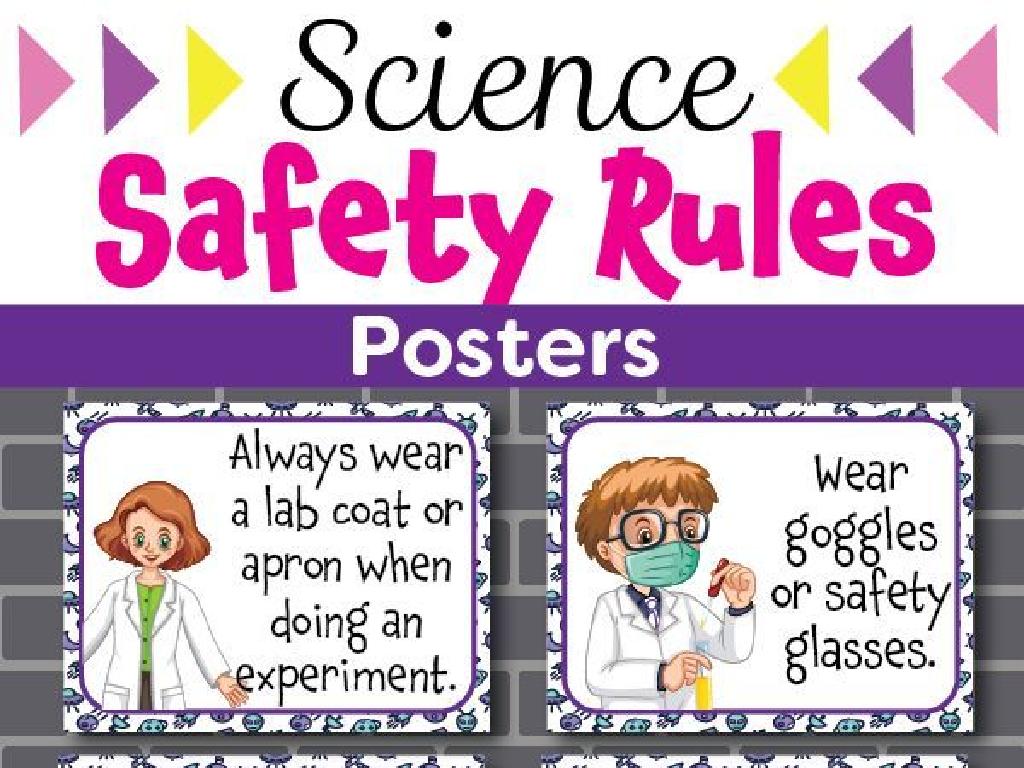Understanding The Chemistry Of Cellular Respiration
Subject: Science
Grade: Seventh grade
Topic: Biochemistry
Please LOG IN to download the presentation. Access is available to registered users only.
View More Content
Introduction to Cellular Respiration
– Exploring Biochemistry
– Focus on Cellular Respiration
– The process cells use to make energy from food
– Why it’s vital for life
– Provides energy that fuels cell activities
– The role in energy production
– Converts glucose into ATP, the energy currency of cells
|
This slide introduces students to the concept of cellular respiration within the field of biochemistry. Cellular respiration is a critical biochemical process that allows cells to convert nutrients into energy. This energy, in the form of adenosine triphosphate (ATP), is essential for powering various cellular functions and maintaining life. It’s important to convey to students that without cellular respiration, cells would not be able to perform the tasks necessary for survival. Use analogies like comparing ATP to a rechargeable battery that powers a cell to help students grasp the concept. Encourage questions to ensure understanding before moving on to more detailed aspects of the process.
Exploring Biochemistry and Cellular Respiration
– Biochemistry: life’s chemistry
– Study of chemical processes in organisms
– Linking Biochemistry & respiration
– How cells generate energy through reactions
– Biochemistry in everyday life
– Fermentation in yogurt, energy in humans
– Understanding cellular respiration
– Cells converting glucose into energy
|
This slide introduces students to the concept of Biochemistry, which is the study of chemical processes within and related to living organisms. It’s important to explain that cellular respiration is a key biochemical process where cells convert food into the energy they need to function. Use everyday examples like how yeast ferments sugar to create yogurt or how our bodies convert food into energy to make the topic relatable. Emphasize that understanding cellular respiration is crucial for grasping how organisms obtain energy. Encourage students to think of more examples where biochemistry is at work in their daily lives.
The Basics of Cellular Respiration
– What is cellular respiration?
– It’s a process cells use to make energy from food
– Glucose and oxygen’s role
– Glucose is broken down, oxygen is used to release energy
– Three stages of respiration
– Glycolysis, Krebs Cycle, Electron Transport Chain
– Significance in energy production
|
Cellular respiration is a fundamental biochemical process where cells convert nutrients into energy. It’s essential for students to understand that glucose and oxygen are vital for this process, as glucose is the primary fuel, and oxygen acts as the final electron acceptor in the chain of reactions. The three stages of cellular respiration Glycolysis, Krebs Cycle, and Electron Transport Chain each play a critical role in energy production. Glycolysis breaks down glucose into pyruvate, the Krebs Cycle processes pyruvate into electron carriers, and the Electron Transport Chain generates the majority of the cell’s ATP, the energy currency. Emphasize the importance of each stage and how they connect to each other. This slide will serve as an introduction to the more detailed exploration of each stage in subsequent slides.
Glycolysis: Initiating Cellular Respiration
– Glycolysis breaks down glucose
– Glucose is split into two molecules of pyruvate, releasing energy
– Occurs in the cell’s cytoplasm
– The cytoplasm is the fluid inside cells where glycolysis happens
– ATP, NADH, and pyruvate are key
– ATP is energy currency, NADH carries electrons, pyruvate is end product
– First step in energy release process
|
Glycolysis is the first stage of cellular respiration, a critical process for energy production in cells. During glycolysis, one molecule of glucose is broken down into two molecules of pyruvate. This process occurs in the cytoplasm and results in a net gain of two ATP molecules, which are used by the cell for energy. NADH is also produced, which will be used later in the respiration process to generate more ATP. It’s important for students to understand that glycolysis is an anaerobic process, meaning it does not require oxygen. This will set the foundation for learning about the subsequent steps of cellular respiration that occur in the mitochondria and require oxygen.
Krebs Cycle: The Second Stage of Cellular Respiration
– Pyruvate’s journey in mitochondria
– Pyruvate from glycolysis enters mitochondria, transforming into Acetyl-CoA.
– Krebs cycle reaction cycle
– A series of chemical reactions within the mitochondria matrix.
– ATP and NADH production
– Each turn of the cycle generates ATP and stores energy in NADH.
– Energy release process
|
The Krebs Cycle, also known as the Citric Acid Cycle, is the second stage of cellular respiration and takes place in the mitochondria. It starts with pyruvate from glycolysis being converted into Acetyl-CoA before entering the cycle. The cycle itself is a complex series of chemical reactions that result in the release of energy, which is captured in the form of ATP and NADH. It’s important for students to understand that this cycle is a key part of how cells generate energy from food. Instruct students on the significance of each step of the cycle and how the energy carriers ATP and NADH are used in the cell. Provide examples of how this energy is used in everyday activities, such as exercise or thinking.
Electron Transport Chain: The Powerhouse Phase
– High-energy electrons from NADH
– Electrons provide energy to pump protons, creating a gradient
– Inner mitochondrial membrane’s role
– It’s where electron transport and ATP synthesis occur
– ATP generation
– Up to 34 ATP molecules are produced for every glucose molecule
– Significance for cellular energy
|
The Electron Transport Chain (ETC) is the final and most complex stage of cellular respiration. It takes place in the inner mitochondrial membrane. Here, high-energy electrons from NADH and FADH2 are transferred through a series of proteins. As electrons move through the ETC, their energy is used to pump protons across the membrane, creating a proton gradient. This gradient powers ATP synthase to generate ATP, the cell’s energy currency. Students should understand that the ETC is a critical step in energy production, yielding a significant amount of ATP that cells use for various functions. Emphasize the efficiency of the ETC and its importance in overall metabolism.
The Importance of Oxygen in Cellular Respiration
– Oxygen’s role in respiration
– Oxygen helps break down food molecules to release energy.
– Anaerobic respiration effects
– Without oxygen, cells switch to anaerobic respiration, less efficient.
– Breathing vs. Cellular respiration
– Breathing supplies oxygen for respiration; not the same process.
– Oxygen’s impact on energy production
– Adequate oxygen allows cells to produce maximum energy.
|
This slide aims to explain the critical role of oxygen in cellular respiration, a process that powers every cell in the body. Oxygen is essential for breaking down glucose into water, carbon dioxide, and energy during aerobic respiration. In the absence of oxygen, cells can perform anaerobic respiration, but this process is less efficient and can lead to the buildup of lactic acid. It’s important to distinguish between the act of breathing, which brings oxygen into the body, and cellular respiration, which uses that oxygen at the cellular level. Understanding this connection highlights the importance of oxygen in efficiently producing energy for the body’s needs. Encourage students to think about how activities like exercise increase the need for oxygen and energy.
ATP: The Energy Currency of the Cell
– What is ATP?
– ATP, or Adenosine Triphosphate, is the cell’s main energy source.
– ATP’s role in energy storage
– ATP stores energy in its high-energy phosphate bonds.
– Releasing energy from ATP
– Energy is released when ATP is broken down into ADP and a phosphate group.
– ATP in cellular functions
– ATP powers various cellular processes like muscle contraction and nerve impulse propagation.
|
ATP, or Adenosine Triphosphate, is often referred to as the energy currency of the cell because it is the primary molecule used by cells to store and transfer energy. It is crucial for students to understand that ATP is not energy itself, but rather it stores energy within its high-energy phosphate bonds. When the cell needs energy, ATP is broken down into ADP (Adenosine Diphosphate) and a phosphate group, releasing energy that can be used for cellular activities. This slide will explain the central role of ATP in cellular respiration and its importance in various cellular functions, including muscle contraction, active transport, and biosynthetic reactions. Encourage students to think of ATP as a rechargeable battery that powers the cell’s activities.
Real-World Applications of Cellular Respiration
– Cellular respiration in athletics
– Athletes optimize performance by managing oxygen and glucose for energy.
– Weight management connection
– Balancing food intake and energy use is key for weight control.
– Diseases from respiration issues
– Conditions like mitochondrial disorders affect energy production.
– Understanding impacts daily life
|
This slide aims to connect the concept of cellular respiration with its practical applications in everyday life. Students will learn how athletes use the principles of cellular respiration to enhance their performance by efficiently using oxygen and glucose to generate energy. They will also understand the role of cellular respiration in weight management, as it is the process by which the body converts food into the energy it needs, and how excess food can lead to weight gain if not balanced with energy use. Additionally, the class will discuss diseases that are caused by malfunctions in cellular respiration, such as mitochondrial disorders, which can lead to fatigue and muscle weakness. This discussion will help students appreciate the importance of biochemistry in health and everyday activities.
Class Activity: Simulating Cellular Respiration
– Understand respiration with a lab
– Gather materials for the experiment
– Glucose solution, yeast, balloons, test tubes needed
– Observe CO2 production
– CO2 inflates the balloon, indicating respiration
– Discuss the results as a class
|
This class activity is designed to give students a hands-on experience with cellular respiration. The experiment will use yeast to break down glucose solution, producing CO2 gas as a byproduct, which will inflate the balloons attached to the test tubes. This visual representation helps students understand that cellular respiration is a process that releases energy from glucose, with carbon dioxide as a waste product. Teachers should ensure that students follow safety guidelines while handling materials. Possible variations of the activity could include changing the amount of glucose or yeast, comparing with another substance instead of glucose, or measuring the rate of balloon inflation to infer the rate of respiration.






